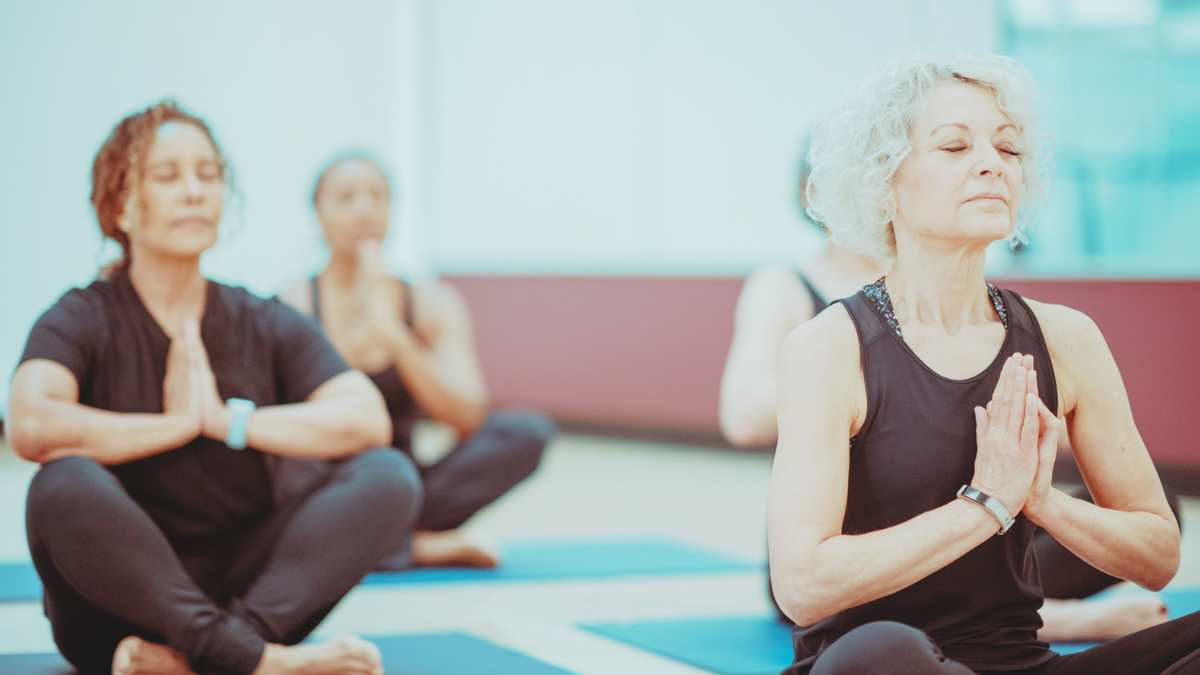Meditation is as complex as your mind is.
It is also as simple as sitting down and breathing. But even if you’re not quite sure about the details, you’ve probably heard that meditation is good for you.
In addition to managing stress, mindfulness practices have been linked to better outcomes for patients with heart disease, cancer, high blood pressure, depression, and many other conditions.
There are many myths about meditation you may have heard. It’s easy to see why it’s sometimes misunderstood.
This guide will help you sort out the facts so you can discover the true benefits of meditation and how it might change your life for the better.
Myth #1: It’s okay to discontinue medical treatment.
Truth: Talk with your doctor before making any decisions about your health. Meditation may reduce your need for prescription drugs or it may be a helpful supplement to conventional care.
Myth #2: Only the full lotus position counts.
Truth: Take any seat that’s comfortable for you. That may mean a half lotus on the floor or sitting in a straight-backed chair.
Myth #3: Aches and pains are good.
Change positions if you feel stiff or get a cramp. Scan your body to detect areas of tension and make adjustments. You’ll eliminate distractions and protect your body from injury.
Myth #4: Teachers are useless.
On the contrary, you can learn a lot from books and videos. Live teachers are even better because you can form a warm and supportive relationship. Feeling accountable to another person may also encourage you to practice more consistently.
Myth #5: Expensive props make a big difference.
Just go ahead and select a cushion that works well for you. You can also use your bed pillow or an old phonebook. Your mind is what really counts.
Myth#6: Absolute quiet is essential.
Silence is conducive to meditation, but it can be difficult to find in the modern world. Work on accepting background noise with a peaceful mind.
Myth#7: It requires a lot of time.
You can meditate for just a few minutes a day. Focus on your breathing when you’re stuck at a red light. Remind yourself of all you have to be grateful for while waiting for your coffee to brew.
Myth#8: It requires little time.
Prolonged contemplation leads to deeper insights. You can always adjust your priorities depending on what you want to accomplish.
Myth#9: Concentrate first.
Your thoughts may be accustomed to racing around. Over time, you will enhance your ability to concentrate
Myth#10: Zoning out is the ultimate goal.
Meditation can be used just to relax. You can also use your sessions to sort out personal issues or seek spiritual attainments.
Myth#11: It’s some kind of religion.
Meditation is a traditional part of many religions. It can also be adapted to your personal spiritual beliefs or be a completely secular activity.
Myth#12: You’ll wind up isolated.
Sitting by yourself can actually strengthen your connections with others. You’ll develop more love and compassion.
Myth#13: Breathing is just for beginners.
Watching your breathing or counting your inhalations and exhalations is a common technique when you’re starting out. Train carefully. Deep and relaxed breathing is essential at every stage of meditation.
Myth#14: Progress feels gradual and steady.
Expect fluctuations. Some sessions will go smoothly and sometimes you’ll struggle.
Myth#15: Meditation is easy.
Mindfulness can be hard work. To make breakthroughs in thinking, address your automatic defenses. To set out in a more positive direction, transform your entrenched habits.
The final myth is that meditation is difficult. Meditation can also be simple and fun. Be gentle with yourself. Lighten up and enjoy the process.
As you can see, meditation practice is full of contradictions.
They’re also immensely rewarding and worth all the effort. Clear up the myths and boost your physical and mental well-being through meditation.
Mindfulness Meditation
Or, how to be in the moment … right here, right now.
You might begin to notice the variety of sights and sounds in your environment. Within your space you can then become aware of your body, its posture and all of its sensations such as those coming from skin, muscles, organs and so on.
Take this moment to tune into your breath, noticing the natural process of breathing in and out. Notice the sensations and movements associated with breathing – in your lungs, chest and abdomen, for example.
Keep breathing naturally as you now observe your current feelings or the quality of your emotions. You can also take notice of your thoughts, accepting them as they are, rather than dismissing or altering them.
Right now, you have an opportunity to just be.
Pause and grant yourself a short break. Gently close your eyes, if appropriate, and for a few quiet minutes, be still.
Follow the above suggestions to openly explore your body, breath, feelings and thoughts at this moment. Begin now and then read on when you are done.
Well done!
You have just completed a short mindfulness exercise. For those who declined the invitation, there is still time to go back and have that experience.
What Is Mindfulness?
 Mindfulness is commonly defined as paying purposeful attention to one’s moment-to-moment experience in a non-judgemental and accepting way.
Mindfulness is commonly defined as paying purposeful attention to one’s moment-to-moment experience in a non-judgemental and accepting way.
Mindfulness can be considered to be a natural capacity of the human mind. But because we typically shape our mind to wander and be distracted, mindfulness must be cultivated by regularly engaging in techniques that explicitly promote paying attention to the moment.
Increasing mindfulness has a number of benefits including improved psychological well-being and reduced symptoms of anxiety and depression.
Accordingly, there has recently been a dramatic uptake of mindfulness training by individuals seeking to improve their health and well-being or to improve their performance in education, sport or corporate settings.
But as promising as the benefits of mindfulness seem to be, the research evidence supporting its efficacy is not conclusive. We don’t yet understand how exactly it works.
One line of thought is based on the capacity of the practices to change the brain in ways that lead to increased attention and cognitive abilities. These changes arise because the techniques of mindfulness emphasise the use of regions of the brain responsible for attentiveness, discernment and behaviour control.
By strengthening these faculties, the brain is better able to regulate emotions and stress. It also becomes better at higher-order processes like divergent thinking, which is an element of creativity.
Researchers are exploring other potential benefits. This year, for example, my colleagues and I published research on the quality of life and emotional well-being benefits of mindfulness development for stroke survivors.
One common debilitating consequence of stroke and other neurological conditions, such as multiple sclerosis, is fatigue. My research review provides preliminary evidence that mindfulness-based interventions may reduce the symptoms of fatigue in those living neurological conditions.
Other researchers are investigating the benefits of mindfulness interventions for chronic fatigue syndrome, cancer-related fatigue and management of chronic pain.
More broadly, research is exploring how mindfulness can support lifestyle changes as part of treatment of medical conditions such as diabetes, high blood pressure and heart disease.
Getting Started
Although mindfulness is considered to be relatively safe, before starting out, those with an existing physical or mental health condition should first talk to a health professional. Mindfulness practices should not replace or delay conventional health care.
A variety of techniques can be used to cultivate mindfulness. Some involve purposeful movements such as yoga asana or tai chi, while others are meditation-based.
No conclusive evidence indicates that one technique is superior to another. The technique must emphasise mindfulness development at a level appropriate to one’s experience and preference. Beyond that, participation and outcomes are determined by intention, motivation, expectations and attitudes.
It is common for people to learn a mindfulness technique by completing a mindfulness course. They then integrate the technique into their daily routine. Regularity of practice is important, even if it is for just a few minutes each day.
As with any skill, learning mindfulness can be quite frustrating. For many, this is the significant barrier to their practice. Working with frustration, or boredom, often provides the initial important lessons of mindfulness.
A well-trained and experienced instructor will ensure the novice is well supported and receives adequate feedback on their progress. And the rapport between instructor and trainee is increasingly being recognised as another important factor developing mindfulness.
In summary, the best way to learn about mindfulness is to practise it. As Albert Einstein said:
Learning is experience. Everything else is just information.
Mindfulness section author: Maarten Immink, Senior Lecturer, Human Movement, University of South Australia – republished from The Conversation under a Creative Commons license.
Last Updated on November 6, 2023

